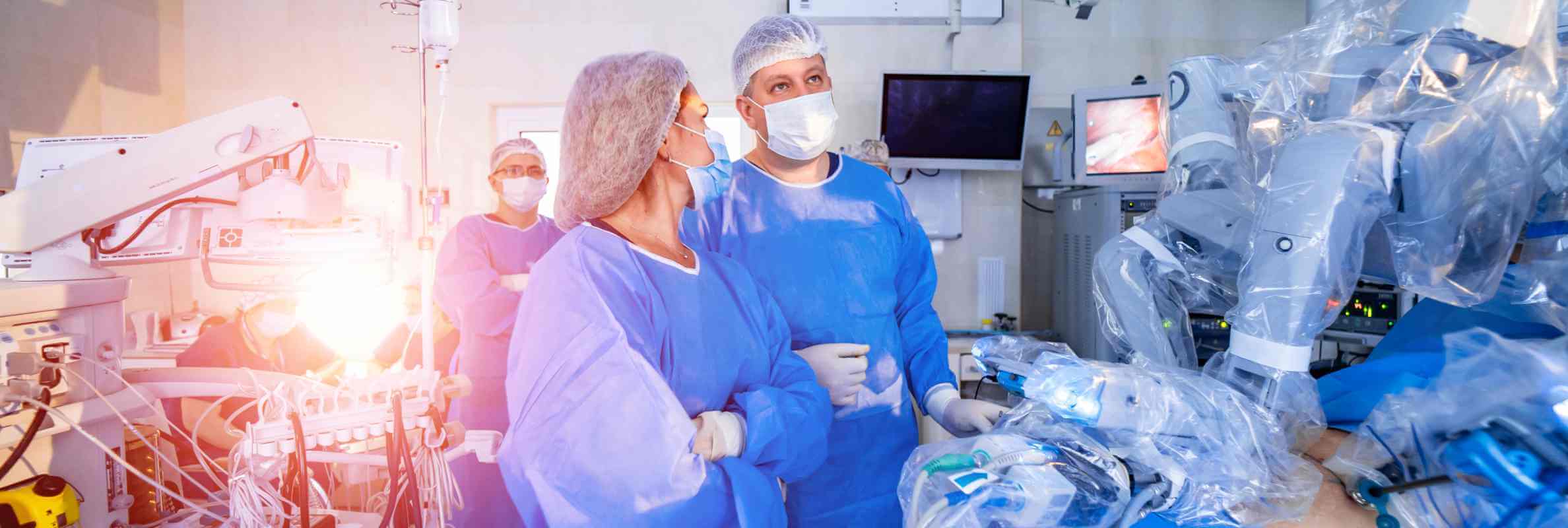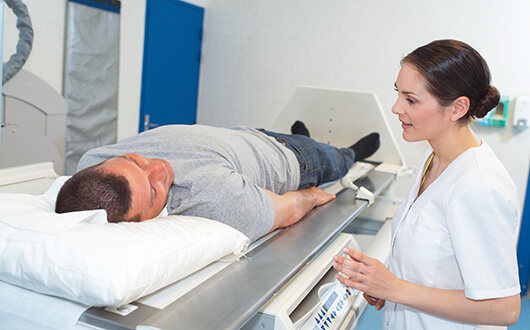Prostate cancer is one of the three most common cancers among men. The main method of treatment for stage 4 prostate cancer is surgical intervention – a radical prostatectomy. Currently, surgeons from the leading foreign clinics prefer performing a robot-assisted prostatectomy. The use of the da Vinci robotic system ensures the highest precision and minimal tissue damage during the surgical procedures.
Content
- Types of prostatectomy for prostate cancer
- Peculiarities of the robot-assisted prostatectomy for prostate cancer
- Advantages of the robot-assisted prostatectomy for prostate cancer
- Disadvantages of the robot-assisted prostatectomy for prostate cancer
- Where is the robot-assisted prostatectomy for prostate cancer performed?
- The cost of a prostatectomy for prostate cancer with a da Vinci robot, in different countries
- How to undergo treatment for prostate cancer abroad
Types of prostatectomy for prostate cancer
Until recently, the radical prostatectomy was performed with an open surgery – through a long incision in the lower abdomen. During this operation, the surgeon removes the prostate with the overlying part of the urethra, seminal vesicles, and regional lymph nodes. Afterwards, the doctor sutures the transected urethra to the bladder neck. The main goal of the operation is achieved – the prostate tumor is removed. However, in performing an open prostatectomy, there is a significant risk of complications: profuse blood loss, wound infection, erectile dysfunction, and urinary incontinence.
The robot-assisted prostatectomy is the alternative to the conventional open surgery. It should be noted that in Western Europe and the United States, most prostate surgeries are performed using a robot. This is not surprising, as the robotic prostatectomy has a number of advantages over the conventional surgical intervention.
Peculiarities of the robot-assisted prostatectomy for prostate cancer
A robot-assisted prostatectomy is the most advanced surgical technique for the treatment of prostate cancer. Patients often wonder if the operation is performed by a robot or by a doctor. The robot does not have artificial intelligence, so it cannot make independent decisions. The robotic system is operated by a doctor who sits at the control console. Such operations can only be performed by specially trained surgeons.
During the intervention, the doctor looks at the screen, which displays an image of the operating field in multiple magnification. Thus, the surgeon can monitor the progress of the operation. A video magnification of the operating field allows the doctor to determine the localization of anatomical structures more accurately. In particular, the nerves that are responsible for urination and erection.
The doctor performs all surgical manipulations with the help of robot manipulators. The robot has four "arms" in total. One "hand" holds the video camera, which transmits the image of the surgical field to the monitor, the other "hands" hold the surgical instruments. The manipulators of the robot resemble human hands, but their functionality is better. The arms can bend in all directions and rotate at any angle. This makes it possible to perform the removal of the prostate gland with the highest precision, without the risk of damaging important anatomical structures that are located nearby.
A robot-assisted prostatectomy is performed through a laparoscopic approach. The surgeon makes only a few small incisions in the patient's abdomen, and inserts instruments to perform surgical procedures through them. The essence of the operation is the same as in an open prostatectomy.
Advantages of the robot-assisted prostatectomy for prostate cancer
A prostatectomy can be carried out in a variety of ways. However, the robot-assisted prostatectomy is becoming more and more popular. Today, it is the most effective and safe method of prostate cancer treatment.
The advantages of robot-assisted prostatectomy versus open surgery are as follows:
- Reduced blood loss during surgery. The need for a donor blood transfusion is minimized.
- Minimal risk of damaging the nerves that are responsible for erection and urination. This became possible thanks to high-precision movements of the robot and video magnification of the operating field.
- Shorter rehabilitation period. The robot-assisted prostatectomy is a minimally invasive intervention. Patients recover in a few days and do not need long-term care.
- Less pronounced pain syndrome in the postoperative period. There is no need to administer a lot of painkillers.
- Excellent cosmetic result. Postoperative scars are small and almost invisible.
Disadvantages of the robot-assisted prostatectomy for prostate cancer
The robot-assisted prostatectomy has already become the "gold standard" for surgical prostate cancer treatment. However, this treatment method also has several drawbacks.
So, the disadvantages of the robot-assisted operation include:
- High cost of the procedure. The purchase and maintenance of a robotic system requires a medical institution to spend large amounts of money.
- Limited availability of the procedure. There is no da Vinci robot in every city. Patients have to travel to other cities and even countries.
- Lack of medical personnel. Only surgeons who have undergone special training can perform robotic operations.
Where is the robot-assisted prostatectomy for prostate cancer performed?
In Western Europe and the United States, operations have long been carried out with the help of the da Vinci robotic system. Foreign surgeons have improved their skills almost to perfection. A patient who is operated on by an experienced urologist-oncologist can be sure that the operation will cause no complications.
The top countries that perform robot-assisted prostatectomy are:
- Germany
- Turkey
- South Korea
- Israel
- Switzerland
In Germany, robot-assisted operations are ubiquitous. Almost all large clinics in Germany have been performing this kind of surgery for a long time. For example, University Hospital Erlangen started practicing this treatment method back in 2012. Since then, thousands of successful robot-assisted prostatectomies have been performed there.
The cost of a prostatectomy for prostate cancer with a da Vinci robot, in different countries, is as follows:
| Average price | |
|---|---|
| Germany | 25,240 EUR |
| Turkey | 31,450 EUR |
| South Korea | 15,300 EUR |
How to undergo treatment for prostate cancer abroad
The medical tourism operator, Booking Health will help arrange your diagnostics and treatment of prostate cancer abroad. We will select the most competent clinic for you, where the robot-assisted prostatectomy is performed at the highest level. You will not need to deal with any organizational issues. Negotiating with the clinic, preparing medical documents, booking air tickets and hotels – all these are the tasks of your Booking Health managers.
In addition, Booking Health is ready to offer its clients the most favorable conditions for treatment abroad. We cooperate directly with the leading foreign clinics, in particular, with the German ones. Therefore, medical institutions offer Booking Health patients prices for local residents, without extra charges and additional coefficients. If you want to be treated by the world's best urologist-oncologists, just use the services of Booking Health.
Choose treatment abroad and you will for sure get the best results!
Authors:
This article was edited by medical experts, board-certified doctors Dr. Nadezhda Ivanisova, and Dr. Bohdan Mykhalniuk. For the treatment of the conditions referred to in the article, you must consult a doctor; the information in the article is not intended for self-medication!
Our editorial policy, which details our commitment to accuracy and transparency, is available here. Click this link to review our policies.
Sources:
National Center for Biotechnology
Read:
Lutetium 177-PSMA: a new generation drug for prostate cancer treatment
Revolutionary Immunotherapy Treatments for Prostate Cancer in Germany
Don't know where to start?
Contact Booking Health





